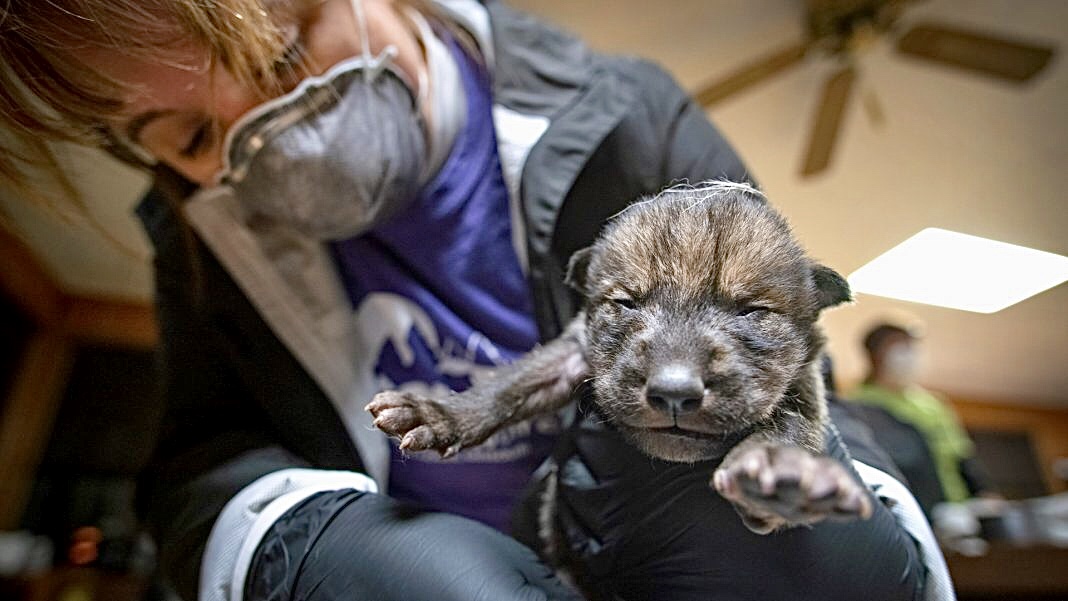9 Critically Endangered Mexican Gray Wolf Pups Born In Captivity Will Be Released Into The Wild & Raised By Wolf Packs In Arizona & New Mexico

Photos from the Endangered Wolf Center
The Endangered Wolf Center recently flew nine critically endangered Mexican gray wolf pups to be fostered by three separate wild wolf packs in New Mexico and Arizona. This historic collaborative effort between the Endangered Wolf Center, the U.S. Fish and Wildlife Service, and its partners represents the first time nine pups born in captivity from one location have been released into the wild to be raised by wild wolf packs.
Born at the Endangered Wolf Center in April, the three male and five female wolf pups, named Jose, Bandelier, Rusty, Regina, Nora, Sidonia, JeanTabaka, Kachina, and Grace, were placed into the Elkhorn, San Mateo, and Dark Canyon Packs.

These nine pups greatly contributed to making 2020 a record-breaking foster season; 20 pups total were placed in the wild this spring from five different zoos and conservation facilities; a 66% increase over the previous highest year. Since captive-to-wild foster efforts started in 2016, 50 captive pups have been placed into wild dens, more than half of which were born at the Endangered Wolf Center.
“The Mexican wolf is one of the most critically endangered mammals in the world, and pushing fosters forward is vital to saving this amazing wolf,” Regina Mossotti, Director of Animal Care and Conservation at the Endangered Wolf Center said in a statement. “As always, this foster was a great example of the U.S. Fish and Wildlife Service, the Species Survival Plan, and the states working together to seize a unique opportunity to help Mexican wolves.”

Fostering is a conservation strategy that takes wolf pups born in one litter and places them with another litter in the wild with the hope that the wolf mother will adopt the new additions as her own; the goal of which is to increase genetic diversity.
With fewer than 200 Mexican grey wolves left in the wild, these nine pups born at the Endangered Wolf Center represent vital new genetics needed for a critically endangered population. Mexican gray wolves in the SSP’s captive population have more genetic diversity than the wild population. The foster technique also provides a unique opportunity for captive born pups to be raised by wild parents.
These efforts are important because the Mexican wolf is a keystone species, which means that the ecosystem and the plants and animals in it rely on the wolves to keep it in balance. This helps reduce the spread of disease and creates a healthier environment for animals, plants, and humans.
“Understanding how human health is linked to our ecosystem’s health shines a light on the importance of these foster efforts,” said Virginia Busch, CEO of the Endangered Wolf Center. “Now, more than ever, we need to prioritize restoring damaged ecosystems, saving endangered species, and protecting our remaining wildlife and wildlands.”
Managing the shifting landscape during the pandemic made partnering with individuals crucial in order to overcome challenging logistics. This year’s operation almost did not occur due to the coronavirus pandemic, but the team came together quickly to develop a strategic and thoughtful protocol to keep the humans and the animals protected during the conservation efforts.
Extreme mountainous terrain and other logistics make fostering challenging, and the timing has to be just right. Wild and captive litters have to be born within a few days of one another, and the transfer from managed care to the wild has to occur before the pups are fourteen days old.
“There are weather considerations, flights, travel, personnel, locating wild dens, securing funding—all pieces of the puzzle have to come together very quickly to get this accomplished,” said Mossotti.
California Wolf Center in Julian, California, and Sevilleta Wolf Management Facility in La Joya, New Mexico, also fostered pups that were released into the wild this year.
You can help all animals and our planet by choosing compassion on your plate and in your glass. #GoVeg
